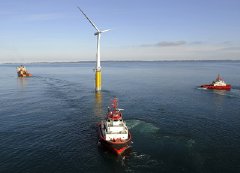Jun 11 2009
StatoilHydro and Siemens installed the world's first large-scale floating wind turbine. The turbine is located approximately 12 km south east of Karmøy in Norway at a water depth of about 220 meters. The Hywind project was developed by StatoilHydro, and Siemens supplied the SWT-2.3 MW wind turbine with a rotor diameter of 82 meters. Over the next two years the floating wind turbine will be tested to provide a thorough analysis of this innovative concept. The Hywind turbine will be connected to the local grid and is expected to start producing power in mid-July.

Hywind is designed to be suitable for installation in water depths between 120-700 m, which could open up for many new possibilities within offshore wind turbine technology. Existing offshore turbines are mounted firmly on the seabed. However, foundations become very expensive at water depths of more than 30-50 m. This might limit the large scale exploitation of offshore wind power particularly in countries with little or now shallow water areas near the coast line. "Hywind could open for new opportunities for exploitation of offshore wind power, as the turbines could be placed much more freely than before", says Henrik Stiesdal, CTO of the Siemens Wind Power Business Unit.
The wind turbine supplied by Siemens is a SWT-2.3-82 with a 65 meter hub height. StatoilHydro is responsible for the floating structure, which consists of a steel floater filled with ballast. This floating element extends 100 m beneath the surface and is fastened to the seabed by three anchor wires.
StatoilHydro and Siemens have jointly developed a special control system for the Hywind turbine to address the special operating conditions of a floating structure. In particular, the advanced control system takes advantage of the turbine's ability to dampen out part of the wave-induced motions of the floating system.
"Just as when we built the world's first offshore wind farm 18 years ago this project has its particular challenges", said Stiesdal. "We have created an advanced system that we trust will be capable of managing the special operating conditions of the floating turbine. Now as then, Siemens is demonstrating its innovative capabilities, and now as then, we are hopeful that this could lead to the opening of a complete new business area."
Siemens today is the market leader in offshore wind power with more than 600 MW installed in 7 projects and an order backlog of 3.300 MW. Wind turbine plants are an important component of the Siemens environmental portfolio, which earned the company revenues of nearly EUR19 billion in fiscal 2008, roughly a quarter of Siemens total revenues.